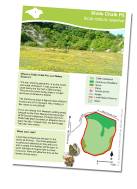SHIDE CHALK PIT
Where is Shide Chalk Pit?
| The reserve covers about 5ha and is on the south-east edge of Newport. It was quarried for chalk during the first half of 20th Century. The prominent west-facing slope is a major landmark on Newport’s skyline. The entrance is down a flight of steps off Burnt House Lane off St George’s Way. Parking in the vicinity is very difficult. |  |
If you are coming from Newport, walking along footpath by the River Medina from the bridge at St George’s Approach (Footpath N218) to Shide Path (N22) provides an attractive way to reach the site. Footpath N28, the Bembridge Trail also runs nearby.
When can I visit?
Local Nature Reserves are open to the public at all times. The chalk grassland is particularly attractive in May and June and a variety of butterflies will be seen on warm still days throughout the summer. In autumn, there are attractive tints as the leaves change colour.
What is so special about Shide Chalk Pit?
Shide Chalk pit is a Site of Special Scientific Interest as it has a chalk grassland flora and a shaded stream, which has a good variety of mosses and liverworts growing by it. Since quarrying stopped, vegetation has been colonising the floor and sides of the pit. As a result, habitats vary from bare rock to emergent woodland, and all stages in between.
The quarry floor supports good quality, short tussocky chalk grassland, which is dominated by Sheep's Fescue. Other species include Horse-shoe Vetch, Salad Burnet, Thyme and Autumn Gentian. Abandoned chalk pits are often good sites for orchids and Shide is no exception, with populations of Bee Orchid, Pyramidal Orchid and Southern Marsh Orchid. In places, the lichen Cladonia rangiformis has become abundant giving a greyish, crisp character to the turf. Rabbits are a major influence in keeping the turf short and adders and common lizards are known to occur.
There is a good variety of butterflies in the area including brimstone, orange tip, holly blue, dingy skipper, green hairstreak, wall brown, green-veined white, speckled wood, comma, small tortoiseshell, common blue, marbled white and chalk hill blue. Nests of the yellow meadow ant are noticeable throughout the site.
The woodland is dominated by Sycamore and Ash, with Hawthorn. Ivy covers much of the woodland floor. The northern slope, nearest to human habitation, includes exotic shrubs like Holm Oak and Sweet Bay whilst the south-west corner contains more native woodland species like Wild Cherry, Field Maple and Spindle.
Scattered scrub areas around the pit slopes are dominated by Privet with Butterfly Bush and Cotoneaster. Sallow grows around the spring and along the main stream the ground flora includes Glaucous Sedge, Hard Rush, Coltsfoot and a good population of Southern Marsh Orchid. This area has a moist, shady environment, which is ideal for mosses and liverworts.
Many common birds nest within the site including great tit and wood pigeon within the wooded areas, blue tit and chaffinch in the scrub, and jackdaw in holes within the steep eastern cliff face. Other birds which have been seen include little owl, green woodpecker, chiffchaff and blackcap; goldcrest and long-tailed tit feed here during the winter.
Page last updated on: 24/03/2011






